The GeForce GTX 660 Ti Review, Feat. EVGA, Zotac, and Gigabyte
by Ryan Smith on August 16, 2012 9:00 AM ESTOC: Power, Temperature, & Noise
Our final task is our look at the overclocking capabilities of our GTX 660 Ti cards. Based on what we’ve seen thus far with GTX 660 Ti, these factory overclocked parts are undoubtedly eating into overclocking headroom, so we’ll have to see just what we can get out of them. The very similar GTX 670 topped out at around 1260MHz for the max boost clock, and between 6.6GHz and 6.9GHz for the memory clock.
| GeForce 660 Ti Overclocking | |||||
| EVGA GTX 660 Ti SC | Zotac GTX 660 Ti AMP | Gigabyte GTX 660 Ti OC | |||
| Shipping Core Clock | 980MHz | 1033MHz | 1033MHz | ||
| Shipping Max Boost Clock | 1150MHz | 1175MHz | 1228MHz | ||
| Shipping Memory Clock | 6GHz | 6.6GHz | 6GHz | ||
| Shipping Max Boost Voltage | 1.175v | 1.175v | 1.175v | ||
| Overclock Core Clock | 1030MHz | 1033MHz | 1083MHz | ||
| Overclock Max Boost Clock | 1200MHz | 1175MHz | 1278MHz | ||
| Overclock Memory Clock | 6.5GHz | 6.8GHz | 6.6GHz | ||
| Overclock Max Boost Voltage | 1.175v | 1.175v | 1.175v | ||
As we suspected, starting with factory overclocked cards isn’t helping here. Our Zotac card wouldn’t accept any kind of meaningful GPU core overclock, so it shipped practically as fast as it could go. We were able to squeeze out another 200MHz on the memory clock though.
Meanwhile our EVGA and Gigabyte cards fared slightly better. We could push another 50MHz out of their GPU clocks, bringing us to a max boost clock of 1200MHz on the EVGA card and 1278MHz on the Gigabyte card. Memory overclocking was similarly consistent; we were able to hit 6.5GHz on the EVGA card and 6.6GHz on the Gigabyte card.
Altogether these are sub-5% GPU overclocks, and at best 10% memory overclocks, which all things considered are fairly low overclocks. The good news is that reference-clocked cards should fare better since their headroom has not already been consumed by factory overclocking, but binning also means the best cards are going to be going out as factory overclocked models.
Moving on to our performance charts, we’re going to once again start with power, temperature, and noise, before moving on to gaming performance.

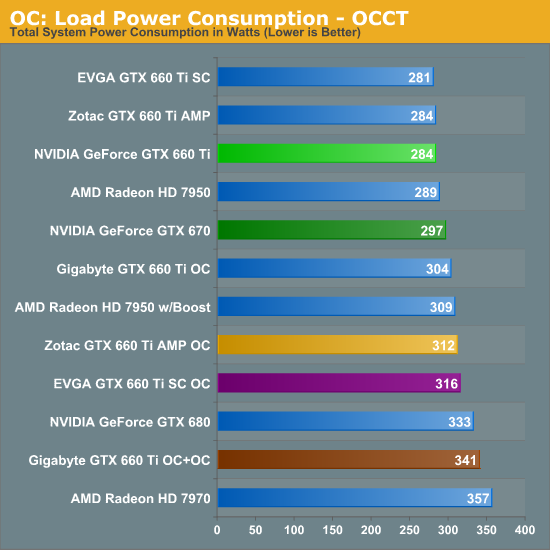
Unsurprisingly, given the small power target difference between the GTX 670 and the GTX 660 Ti, any kind of overclocking that involves raising the power target quickly pushes power consumption past the GTX 670’s power consumption. How much depends on the test and the card, with the higher power target Gigabyte card starting with a particular disadvantage here as its power consumption ends up rivaling that of the GTX 680.
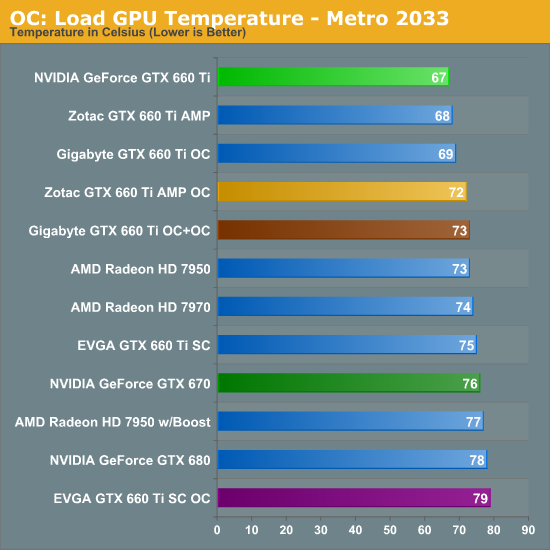
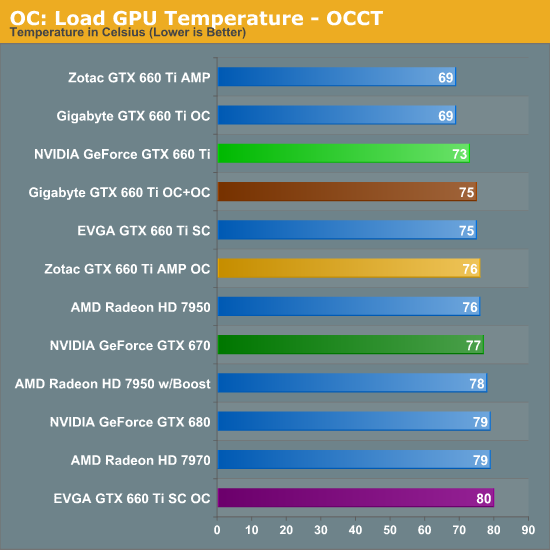
We also see the usual increase in load temperatures due to the increased power consumption. The Zotac and Gigabyte cards fare well enough due to their open air coolers, but the blower-type EVGA card is about as high as we want to go at 80C under OCCT.
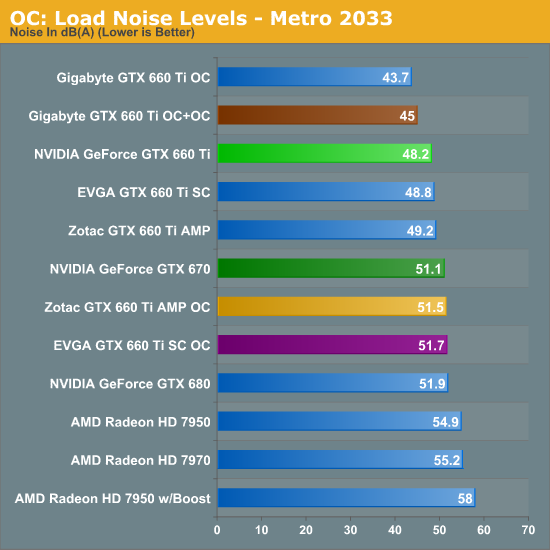
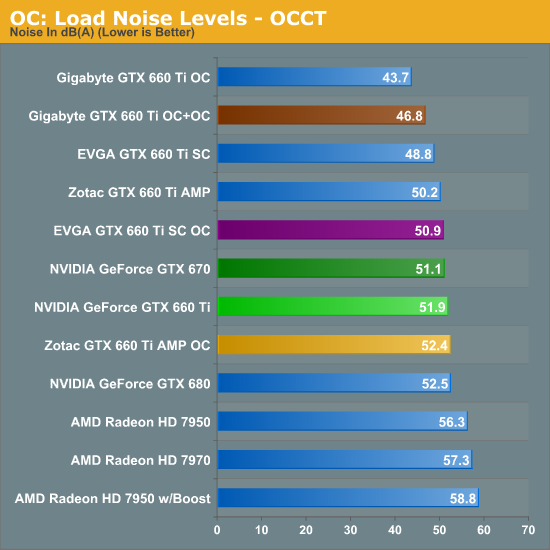
Last but not least, looking at noise levels we can see an increase similar to the temperature increases we just saw. For the Zotac and EVGA cards noise levels are roughly equal with the reference GTX 680, which will be important to remember for when we’re looking at performance. Meanwhile the Gigabyte card continues to shine in these tests thanks to its oversized cooler; even OCCT can only push it to 46.8dB.










313 Comments
View All Comments
CeriseCogburn - Sunday, August 19, 2012 - link
If they can't supply it - it cannot lower competitor prices, and can't be bought, so they make little or no money, and everyone else buys the available competitors product.Why doesn't AMD release a card that drives down the 680's price $170 per card and makes nVidia give away 3 free games with it too ?
That would make too much sense for amd and we consumers and some competition that crushes evil corporate profiteering nVidia, so AMD should do it.
(roll eyes)
To answer your question> nVidia is being nice not draining all the red blood from amd's jugular since amd is bleeding out so badly already that if nVidia took them out a million raging in 3d fanboys would scream for billions in payola in a giant lawsuit they protest for in front of the UN and the IMF and the International Court and the 25k persons traveling EURO unelected power bureaucrats.
So instead of all that terribleness and making amd fans cry, nVidia is nice about it.
Galidou - Tuesday, August 21, 2012 - link
This card at 249$ would be very bad for AMD but not very good for Nvidia either. Considering how close it already is to it's bigger brother, it would probably cut a good percentage of gtx 670 sales.So yeah, 249$ might seem a good price for US but they don't want to harm themselves either.
Belard - Thursday, August 16, 2012 - link
What does TI mean?Where is the GTX 660? So its really a 670 with a hand chopped off?
ericloewe - Thursday, August 16, 2012 - link
TI means something along the lines of "We'll release a crap version later on that only OEMs will buy, called the GTX 660."Patflute - Thursday, August 16, 2012 - link
lolwutOmega215D - Thursday, August 16, 2012 - link
I think it still means "Titanium" version of a chip which was supposedly better than the non-Ti.MrSpadge - Sunday, August 19, 2012 - link
It means "We can't figure out how to distinguish our products using 3 decimal numbers and up to 3 letters in front of it (or the lack thereof), so we'll add some more letters".R3MF - Thursday, August 16, 2012 - link
in the anand review of the 450 where Nvidia first showed the lopsided memory bus arrangement it was noted that CUDA apps would not recognise the full memory complement.has this now been fixed?
Ryan Smith - Thursday, August 16, 2012 - link
Yes. That was fixed almost immediately.R3MF - Thursday, August 16, 2012 - link
thanks Ryan